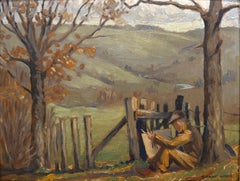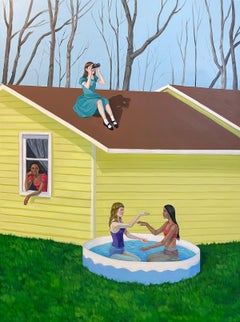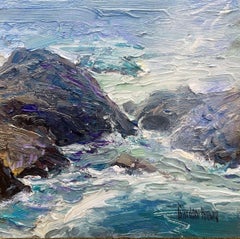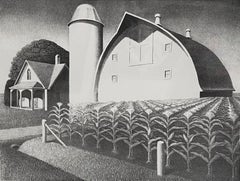Grant Wood Art
American, 1891-1942
One of the major American Regionalist painters along with Thomas Hart Benton and John Steuart Curry, Grant Wood was born in Anamosa, Iowa, and spent his childhood in Cedar Rapids. Unlike Curry and Benton, he never moved East but remained in the Middle West where he found inspiration for his paintings of prosperous farms and people reflecting idealized American values.
However, his work was set apart from many regionalists in that provoked both laughter and social indignation. A good example Daughters of Revolution, 1932, depicting the aloof smugness of women who regarded themselves as emblematic of the country's founding values This painting was a retaliation by Wood against DAR members who had criticized him for completing their window in Germany instead of America. Much of his satire was good natured and humorous.
For two summers, Wood attended the Minneapolis School of Design and Handicraft and Normal Art as a student of Ernest Batchelder, and he had brief times of study at Iowa State University and the Art Institute of Chicago from 1913 to 1916. After World War I, he taught high school art in Cedar Rapids.
Asserting that he "had to go to France to appreciate Iowa," he had several trips abroad, and in 1923 enrolled in the Academie Julian in Paris, but he determined to make his life in Iowa because "all the really good ideas I'd ever had came to me while I was milking a cow."
In 1932, he was co-founder of the Stone City Art Colony and Art School and he became director of the Public Works Art Project in Iowa. He was also an Associate Professor of Fine Arts at the University of Iowa.
His work can be divided into two periods, the first being views of Cedar Rapids, other landscapes including scenes of Europe, and a few portraits. However, in 1928, his work changed when he traveled to Munich to oversee the making of a stained-glass window for the Cedar Rapids Veterans Memorial Building commissioned by the Daughters of the American Revolution. Seeing the severe, austere new style of painting in Germany combined with work from the late Gothic period, he developed a unique new style of his own that treated mid-western subjects with Gothic overtones, satire, and caricature.
In 1930, he produced his first major landscape painting, Stone City, that had exaggerated perspective and unique naive treatment. From that time, his paintings had a simple innocence and fantasy that transported the viewer into another world, often that of a child.
He also did many murals and a few lithographs, completing nineteen between 1937 and 1942, the year he died of cancer at age 50 in Iowa City.
Sources include:
Matthew Baigell, Dictionary of American Art
Michael David Zellman, 300 Years of American Art(Biography provided by Gallery of the Masters)
to
2
2
2
2
Overall Height
to
Overall Width
to
1
1
1
1
1
2
2
7,006
3,377
2,513
1,212
1
1
1
1
Artist: Grant Wood
The Young Artist
By Grant Wood
Located in Palm Desert, CA
"The Young Artist" is an oil on panel painting made in 1926 by Grant Wood. The work is signed lower right, "Grant Wood". The painting size is 11 x 14 x 1 inches. The framed size is 2...
Category
Early 20th Century American Realist Grant Wood Art
Materials
Oil, Panel
July Fifteenth
By Grant Wood
Located in Palm Desert, CA
"July Fifteenth" is a lithograph from 1938 by Grant Wood. The artwork size is 9 3/4 x 12 1/2 inches. The framed size is 17 x 19 1/2 x 5/8 inches. The piece is signed in pencil, lower...
Category
Early 20th Century American Realist Grant Wood Art
Materials
Lithograph
Related Items
Watchers
By Zoe Hawk
Located in Columbia, MO
Zoe Hawk Artist Statement
My work deals with the complex experience of girlhood, exploring adolescent anxiety, feminine identity, and belonging. These themes are tackled within scen...
Category
21st Century and Contemporary American Realist Grant Wood Art
Materials
Oil
"Pacific" Oil Painting
By Gordon Brown
Located in Denver, CO
Gordon Brown's (US based) "Pacific" is an oil painting that depicts rolling waves crashing against a rocky shore.
Bio/artist statement:
"My paintings are all about light and mood,"...
Category
2010s American Realist Grant Wood Art
Materials
Oil
Street Riot Oil Painting Mounted Police WPA artist Social Justice Americana Art
By Arthur Smith
Located in Surfside, FL
Riot, Revolution, Police figures on Horseback in City Streets.
Hand signed lower right.
Painting measures 6 x 12, framed 9 x 15 inches.
Arthur Smith is a...
Category
Mid-20th Century American Realist Grant Wood Art
Materials
Oil, Panel
Poker Players NYC Mid 20th Century Modern WPA American Scene Social Realism
By Philip Reisman
Located in New York, NY
Poker Players NYC Mid 20th Century Modern WPA American Scene Social Realism
Philip Reisman (1904-1992)
Poker Players
12 x 16 oil on board
Signed and dated 1949 lower right
BIO
Phi...
Category
1940s American Realist Grant Wood Art
Materials
Oil, Board
Original 'The Evergreen Playground' Easter Washington State map
Located in Spokane, WA
Original The Evergreen Playground Kroll Map Company vintage poster. Archival linen backed in fine condition. A- condition with only 1 small repair on the outer border in the white area. No tears nor stains.
This map was originally drawn during the Great Depression by Ed Poland, Chief Cartographer of many years here at Kroll Map Company. A pictorial bird's eye view of the Puget Sound...
Category
1940s American Realist Grant Wood Art
Materials
Lithograph
H 33.25 in W 20.75 in D 0.04 in
Woodland (New Hope, Pennsylvania)
By Stow Wengenroth
Located in Fairlawn, OH
Woodlands (New Hope, Pennsylvania)
Lithograph, 1950
Signed by the artist in pencil lower right (see photo)
Annotated: Ed/55 in pencil by the artist lower left (see photo)
Edition: 55...
Category
1950s American Realist Grant Wood Art
Materials
ABS, Lithograph
Original "R. M. S. Caronia, Cunard Line vintage cruise line poster
Located in Spokane, WA
Original, linen-backed travel by Cunard Line cruise ship R.S.S. "Caronia" horizontal poster. This original poster is ready to frame.
RMS Caronia ...
Category
1940s American Realist Grant Wood Art
Materials
Lithograph
H 19.5 in W 21.5 in D 0.05 in
"Misty City", Oil Painting
By Christopher Clark 1
Located in Denver, CO
Christopher Clark's (US based) "Misty City" is an original, handmade oil painting that depicts orange and green hued clouds arching over a water and city lights
Bio/artist statement:
Christopher has been an artist since early childhood, when he would watch Bob Ross on PBS and mimic the famed oil painter’s art with crayons. He considers himself a self-educated artist, with his studies ranging from personal training with contemporary masters, to classical academic art technique, with much inspiration from 19th Century art and the Impressionist Movement. Christopher lived in Italy for a time, immersing himself in Italian culture and art, which continues to influence his painting. His fan base has grown considerably since his return to the US, gaining the attention of Lucasfilm and Marvel Fine Art, which both signed him as an officially licensed artist in 2016. Other clients include George Lucas, Major League Baseball, Louisville Slugger...
Category
2010s American Realist Grant Wood Art
Materials
Canvas, Oil, Panel
Lobsterman's Cove, Winter Harbor, Maine
By Stow Wengenroth
Located in Fairlawn, OH
Lobsterman's Cove, Winter Harbor, Maine
Lithograph, 1941
Signed in pencil lower right (see photo)
Edition 50
Impressions are in the collection of the Pennsylvania Academy of the Fine...
Category
1940s American Realist Grant Wood Art
Materials
Lithograph
The Golden Gate
By Adolf Arthur Dehn
Located in Fairlawn, OH
The Golden Gate
Lithograph on wove paper watermarked GC, 1940
Signed in pencil by the artist (see photo)
Publisher: Associated American Artists
Edition: 189, unnumbered
The image depicts The Golden Gate Bridge which connects San Francisco and Marin County, California
References And Exhibitions:
Illustrated: Adams, The Sensuous Life of Adolf Dehn, Fig. 13.17, page 324
Reference: L & O 325
AAA Index 391
Adolf Dehn, American Watercolorist and Printmaker, 1895-1968
Adolf Dehn was an artist who achieved extraordinary artistic heights, but in a very particular artistic sphere—not so much in oil painting as in watercolor and lithography. Long recognized as a master by serious print collectors, he is gradually gaining recognition as a notable and influential figure in the overall history of American art.
In the 19th century, with the invention of the rotary press, which made possible enormous print runs, and the development of the popular, mass-market magazines, newspaper and magazine illustration developed into an artistic realm of its own, often surprisingly divorced from the world of museums and art exhibitions, and today remains surprisingly overlooked by most art historians. Dehn in many regards was an outgrowth of this world, although in an unusual way, since as a young man he produced most of his illustrative work not for popular magazines, such as The Saturday Evening Post, but rather for radical journals, such as The Masses or The Liberator, or artistic “little magazines” such as The Dial. This background established the foundation of his outlook, and led later to his unique and distinctive contribution to American graphic art.
If there’s a distinctive quality to his work, it was his skill in introducing unusual tonal and textural effects into his work, particularly in printmaking but also in watercolor. Jackson Pollock seems to have been one of many notable artists who were influenced by his techniques.
Early Years, 1895-1922
For an artist largely remembered for scenes of Vienna and Paris, Adolf Dehn’s background was a surprising one. Born in Waterville, Minnesota, on November 22, 1895, Dehn was the descendent of farmers who had emigrated from Germany and homesteaded in the region, initially in a one-room log cabin with a dirt floor. Adolf’s father, Arthur Clark Dehn, was a hunter and trapper who took pride that he had no boss but himself, and who had little use for art. Indeed, during Adolf’s boyhood the walls of his bedroom and the space under his bed were filled with the pelts of mink, muskrats and skunks that his father had killed, skinned and stretched on drying boards. It was Adolf’s mother, Emilie Haas Dehn, a faithful member of the German Lutheran Evangelical Church, who encouraged his interest in art, which became apparent early in childhood. Both parents were ardent socialists, and supporters of Eugene Debs. In many ways Dehn’s later artistic achievement was clearly a reaction against the grinding rural poverty of his childhood.
After graduating from high school in 1914 at the age of 19—an age not unusual in farming communities at the time, where school attendance was often irregular—Dehn attended the Minneapolis School of Art from 1914 to 1917, whose character followed strongly reflected that of its director, Munich-trained Robert Kohler, an artistic conservative but a social radical. There Dehn joined a group of students who went on to nationally significant careers, including Wanda Gag (later author of best-selling children’s books); John Flanagan (a sculptor notable for his use of direct carving) Harry Gottlieb (a notable social realist and member of the Woodstock Art Colony), Elizabeth Olds (a printmaker and administrator for the WPA), Arnold Blanch (landscape, still-life and figure painter, and member of the Woodstock group), Lucille Lunquist, later Lucille Blanch (also a gifted painter and founder of the Woodstock art colony), and Johan Egilrud (who stayed in Minneapolis and became a journalist and poet).
Adolf became particularly close to Wanda Gag (1893-1946), with whom he established an intense but platonic relationship. Two years older than he, Gag was the daughter of a Bohemian artist and decorator, Anton Gag, who had died in 1908. After her husband died, Wanda’s mother, Lizzi Gag, became a helpless invalid, so Wanda was entrusted with the task of raising and financially supporting her six younger siblings. This endowed her with toughness and an independent streak, but nonetheless, when she met Dehn, Wanda was Victorian and conventional in her artistic taste and social values. Dehn was more socially radical, and introduced her to radical ideas about politics and free love, as well as to socialist publications such as The Masses and The Appeal to Reason.
Never very interested in oil painting, in Minneapolis Dehn focused on caricature and illustration--often of a humorous or politically radical character. In 1917 both Dehn and Wanda won scholarships to attend the Art Students League, and consequently, in the fall of that year both moved to New York. Dehn’s art education, however, ended in the summer of 1918, shortly after the United States entered World War I, when he was drafted to serve in the U. S. Army. Unwilling to fight, he applied for status as a conscientious objector, but was first imprisoned, then segregated in semi-imprisonment with other Pacifists, until the war ended. The abuse he suffered at this time may well explain his later withdrawal from taking political stands or making art of an overtly political nature. After his release from the army, Dehn returned to New York where he fell under the spell of the radical cartoonist Boardman Robinson and produced his first lithographs. He also finally consummated his sexual relationship with Wanda Gag.
The Years in Europe: 1922-1929
In September of 1921, however, he abruptly departed for Europe, arriving in Paris and then moving on to Vienna. There in the winter of 1922 he fell in love with a Russian dancer, Mura Zipperovitch, ending his seven-year relationship with Wanda Gag. He and Mura were married in 1926. It was also in Vienna that he produced his first notable artistic work.
Influenced by European artists such as Jules Pascin and Georg Grosz, Dehn began producing drawings of people in cafes, streets, and parks, which while mostly executed in his studio, were based on spontaneous life studies and have an expressive, sometimes almost childishly wandering quality of line. The mixture of sophistication and naiveté in these drawings was new to American audiences, as was the raciness of their subject matter, which often featured pleasure-seekers, prostitutes or scenes of sexual dalliance, presented with a strong element of caricature. Some of these drawings contain an element of social criticism, reminiscent of that found in the work of George Grosz, although Dehn’s work tended to focus on humorous commentary rather than savagely attacking his subjects or making a partisan political statement. Many Americans, including some who had originally been supporters of Dehn such as Boardman Robinson, were shocked by these European drawings, although George Grocz (who became a friend of the artist in this period) admired them, and recognized that Dehn could also bring a new vision to America subject matter. As he told Dehn: “You will do things in America which haven’t been done, which need to be done, which only you can do—as far at least as I know America.”
A key factor in Dehn’s artistic evolution at this time was his association with Scofield Thayer...
Category
1940s American Realist Grant Wood Art
Materials
Lithograph
Going Home, Lithograph by Georges Schreiber
By Georges Schreiber
Located in Long Island City, NY
Artist: Georges Schreiber, Belgian/American (1904 - 1977)
Title: Going Home
Year: circa 1945
Medium: Lithograph, signed and titled in pencil
Image Size: 9.25 x 13.25 inches
Size: 12 ...
Category
1940s American Realist Grant Wood Art
Materials
Lithograph
The Road, - Winter.
By Otto Knirsch
Located in New York, NY
Published by N. Currier, 152 Nassau St. New York. Drawn on the stone by O. Knirsch. Lithograph hand-colored, 1853. This print was produced by Nathaniel Currier's staff as a Christ...
Category
19th Century American Realist Grant Wood Art
Materials
Lithograph
Previously Available Items
Fertility
By Grant Wood
Located in Rancho Santa Fe, CA
Lithograph on wove paper 9 x 12 in. (image size)
12 5/8 x 19 1/8 in. (sheet size)
Signed lower right
Edition of 250
Published by Associated American Artists (AAA), New York
This ite...
Category
1930s American Modern Grant Wood Art
Materials
Lithograph
'July Fifteenth, 1938' — American Regionalism, 1930s
By Grant Wood
Located in Myrtle Beach, SC
Grant Wood, 'July Fifteenth, 1938', lithograph, edition 250, 1938, Cole 5. Signed in pencil. A superb impression on off-white wove paper, with full margins (1 3/16 to 2 inches), in excellent condition. Image size 9 x 11 7/8 inches; sheet size 11 3/4 x 15 7/8 inches. Matted to museum standards, unframed.
Printed by master lithographer George C. Miller. Published by Associated American Artists, New York, in 1938.
Reproduced and Exhibited: 'American Master Prints from the Betty and Douglas Duffy Collection', the trust for museum exhibitions Washington, D.C., 1987; 'Pressed In Time: American Prints 1905-1950', Henry E. Huntington Library and Art Gallery, San Marino, 2007.
Impressions of this work are in the following museum collections: Amon Carter Museum of American Art, Art Institute of Chicago, Cedar Rapids Museum of Art, Des Moines Art Center, Detroit Institute of Arts, Harvard Art Museums, Huntington Library Art Museum, Los Angeles County Museum of Art, Fine Arts Museums of San Francisco, Milwaukee Art Museum, Museum of Fine Arts Boston, National Gallery of Art, Philadelphia Museum of Art, Rhode Island School of Design Museum, Smithsonian America Art Museum, Sioux City Art Center, Whitney Museum of American Art.
ABOUT THE ARTIST
Grant Wood (1892- 1942) was born in Anamona, Iowa, and lived for ten years on a farm in that area. When his father died in 1901, his mother sold the farm and moved to Cedar Rapids, which was to remain the center of Wood’s world. Principally self-taught, Wood received his art education in a summer class at the Minneapolis School of Design, Handicraft and Normal Art; two years at the University of Iowa; and night school at the Art Institute of Chicago. He made several trips to Europe and studied briefly at the Académie Julien in Paris. Wood was cofounder of the Stone City Art Colony and Art School and was director of the Public Works of Art Project in Iowa from 1933-1934. On a trip to Munich in 1928 to supervise the execution of a stained glass window for the Cedar Rapids Veterans Memorial Building, he studied the northern Renaissance masters, whose crystalline realism and work with layered oil glazes influenced his highly-crafted style of painting. Wood’s other sources of inspiration were American folk paintings and nineteenth-century townscapes.
The turning point in Wood’s career came in 1930 when he won a bronze medal at the Art Institute of Chicago for his painting American Gothic. The image received national recognition, and Wood became famous overnight. In 1937, Wood began making lithographs for the Associated American Artists. These works, imbued with the same humorous satire and meticulous craftsmanship that Wood employed in his paintings, are celebrated as iconic images of American Regionalism...
Category
1930s American Modern Grant Wood Art
Materials
Lithograph
Approaching Storm
By Grant Wood
Located in New York, NY
A very good impression of this lithograph. Edition of 250. Signed in pencil, lower right. Published by Associated American Artists, New York.
Category
1940s American Realist Grant Wood Art
Materials
Lithograph
Tree Planting Group — 1930s American Regionalism
By Grant Wood
Located in Myrtle Beach, SC
Grant Wood, 'Tree Planting Group', lithograph, 1937, edition 250, Cole 1. Signed and dated in pencil. A fine, richly-inked impression, on off-white wove pap...
Category
1930s American Realist Grant Wood Art
Materials
Lithograph
Approaching Storm
By Grant Wood
Located in Portland, ME
Wood, Grant. APPROACHING STORM. Lithograph, 1940. Cole 19. 11 7/8 x 9 inches (304 x 230 mm). Published by Associated American Artists in an edition o...
Category
Mid-20th Century American Realist Grant Wood Art
Materials
Lithograph
TREE PLANTING GROUP - Woods First Print
By Grant Wood
Located in Santa Monica, CA
GRANT WOOD (1891 - 1942)
TREE PLANTING GROUP. 1937 (Cole 1)
Lithograph as published by Associated American Artists. Signed and dated in pencil. Edition 2...
Category
1930s American Modern Grant Wood Art
Materials
Lithograph
Original Grant Wood Lithograph 1938 Framed American Investment Quality Rare
By Grant Wood
Located in Buffalo, NY
July Fifteenth, 1938
Lithograph on paper under glass; Associated American Artists, New York, pub.
Edition of 250, hand signed lower right: Grant Wood
Image: 9" H x 12" W
Literature:...
Category
1930s American Modern Grant Wood Art
Materials
Lithograph
Sultry Night - Banned by the Post Office in 1939 - Provenance: Nan Wood
By Grant Wood
Located in Santa Monica, CA
GRANT WOOD ( 1891 - 1942)
SULTRY NIGHT, 1939 (Cole 6)
Lithograph, signed in pencil. Edition 100. In very good condition, Image 9 x 11 3/4 inches, sheet slightly trimmed being 11 1/2...
Category
1930s American Modern Grant Wood Art
Materials
Lithograph
July 15th
By Grant Wood
Located in Washington, DC
Artist: Grant Wood
Medium: Lithograph on paper
Title: July 15th
Year: 1938
Edition Size: 250
Sheet Size: 11 7/8" x 16"
Reference: Cole 5
Signed: Signed in pencil
Published by Associa...
Category
1930s Grant Wood Art
Materials
Lithograph
Cover for “The Pulse” Magazine, February 1907
By Grant Wood
Located in New York, NY
Grant Wood
(American, 1891 – 1942)
Cover for “The Pulse” Magazine, February 1907
Signed with monogram, GDV,
and graduation year ’10, center right
Pen and ink on paper, laid down
18 ¾ x 12 ⅜ inches (47.6 x 31.4 cm)
Provenance: The artist; from whom acquired by:
Mr. and Mrs. Gordon Fennell, Cedar Rapids, Iowa (1898-1985); his estate sale, Leslie Hindman, Chicago, 11 May 1986; where acquired by:
Private Collection, Chicago; by whom consigned to:
Thomas French Fine Arts, Akron, Ohio; from whom acquired in 2006 by:
John C. Fitzpatrick, Iowa City, Iowa, and Eastport, Maine, 2006-2020
Sold for the benefit of the Tides Institute and Museum of Art, Eastport, Maine
Long before there was American Gothic, before Paul Revere, Daughters of Revolution and Parson Weems’ Fable, before the rhythmic landscapes, witty and frightening character studies, and evocative lithographs of the Midwest, the precocious talent of Grant Wood was already in evidence. Wood was essentially self-taught, but precious little of his earliest works survive. The beginnings of his artistic career are to be found at Washington High School in Cedar Rapids. There he and Marvin Cone...
Category
20th Century American Modern Grant Wood Art
Materials
Ink, Laid Paper, Pen
Approaching Storm
By Grant Wood
Located in Portland, ME
Wood, Grant. APPROACHING STORM. Lithograph, 1940. Cole 19. 11 7/8 x 9 inches (304 x 230 mm). Published by Associated American Artists in an edition o...
Category
Mid-20th Century American Realist Grant Wood Art
Materials
Lithograph
TREE PLANTING GROUP
By Grant Wood
Located in Portland, ME
Wood, Grant. TREE PLANTING GROUP. Lithograph, 1937. Edition of 250 published by Associated American Artists. Signed and dated in pencil, lower right. 8 3/8 ...
Category
1930s Grant Wood Art
Materials
Lithograph
Grant Wood art for sale on 1stDibs.
Find a wide variety of authentic Grant Wood art available for sale on 1stDibs. You can also browse by medium to find art by Grant Wood in lithograph and more. Not every interior allows for large Grant Wood art, so small editions measuring 11 inches across are available. Customers who are interested in this artist might also find the work of Reginald Marsh, Armin Landeck, and Cecil Crosley Bell. Grant Wood art prices can differ depending upon medium, time period and other attributes. On 1stDibs, the price for these items starts at $11,800 and tops out at $11,800, while the average work can sell for $11,800.
Artists Similar to Grant Wood
Questions About Grant Wood Art
- Where is Grant Wood from?1 Answer1stDibs ExpertFebruary 13, 2024Grant Wood is from Iowa. The American artist was born in Anamosa, Iowa, in 1891 and grew up in nearby Cedar Rapids. Unlike other American regionalist painters like John Steuart Curry and Thomas Hart Benton, Wood never moved East but remained in the Middle West, where he found inspiration for his paintings of prosperous farms and people reflecting idealized American values. He died in Iowa City, Iowa, in 1942, at the age of 51. Find an extraordinary collection of art for sale on 1stDibs.





